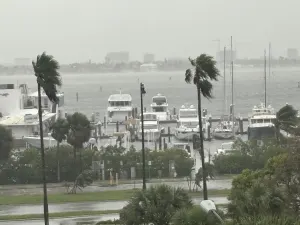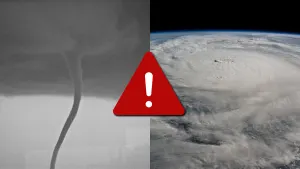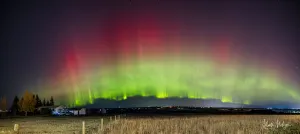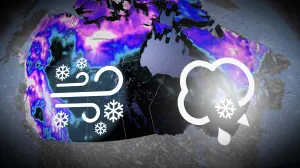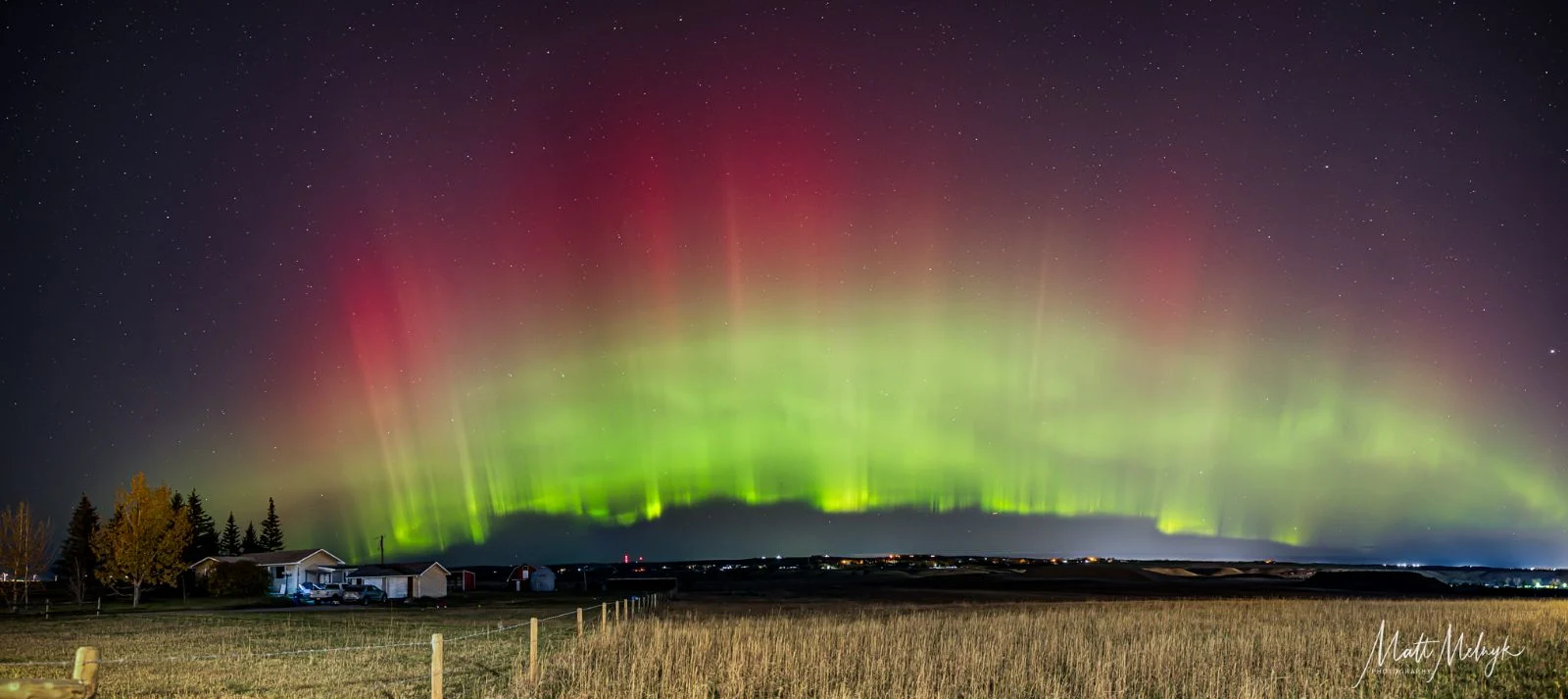
Speedy solar storm could spark bright Northern Lights Thursday night
Eyes to the sky! More aurora displays may be on the way following a powerful solar flare and the eruption of an exceptionally fast solar storm.
A massive cloud of high-energy particles exploded from the Sun overnight, and this fast-moving solar storm could spark bright auroras across Canada and the United States when it arrives on Thursday.
Late on Tuesday night, a powerful explosion went off on the surface of the Sun — an X1.8-class solar flare, originating from sunspot AR3848.

The X1.8-class solar flare is shown here, from around 10 p.m. to midnight EDT, on Tuesday, October 8, 2024. Initially, the flare lights up the surrounding solar matter in the shape of an immense fiery phoenix, and then changes appearance as multiple coronal loops stretch across to bridge the two sides of this immense sunspot. These views are filtered to only capture high energy ultraviolet radiation, at 171 Angstroms, which highlights coronal loops and solar flares. (NASA's Solar Dynamics Observatory)
While not as powerful as the flare we saw back on October 2, it has already had a two-fold effect on Earth.
First, it caused a strong radio blackout event on the day-side of the planet as x-rays and intense ultraviolet radiation bombarded Earth's ionosphere. Second, it unleashed a rare solar radiation storm, as a cloud of high-energy particles was accelerated to near the speed of light by the energy of the flare. Solar radiation storms are capable of causing problems with orbiting satellites, and they can even pose a risk to astronauts on board the International Space Station.
A third impact from this solar flare is still on its way here: an immense coronal mass ejection, aimed directly at Earth.

The initial hour of expansion of the October 9 coronal mass ejection is shown along the top of this composite image, and the next two hours after are shown along the bottom. The bright white arch along the left side of each bottom frame is bright comet C/2023 A3 (Tsuchinshan-ATLAS) passing through the camera's field of view. (NASA-ESA Solar and Heliospheric Observatory)
This bright CME was spotted in the hours after, as it expanded away from the Sun. According to NOAA's Space Weather Prediction Center, this solar storm is travelling exceptionally fast — 1200 to 1300 kilometres per second. That is roughly two and a half times faster than the speed of a typical CME.
Thus, rather than taking the usual two to three days to arrive here, this solar storm is expected to reach Earth as early as Thursday morning.

The October 8-9 coronal mass ejection expands away from the Sun in this composite image from SDO and SOHO. While the left image is a combination of SDO's view of the Sun and both LASCO coronagraph views of the space around the Sun at the same time, the right image is the same but with labels for the CME, the planets Mercury and Venus, Comet Tsuchinshan-ATLAS, background stars, and the "snow" caused by the solar radiation storm's impact on the coronagraph camera. (NASA SDO/NASA-ESA SOHO/Scott Sutherland)
The impact of a coronal mass ejection, and its potential to spark auroras, mainly depends on four factors. The speed, energy, and density of the CME cloud account for three of these. Basically, the more solar matter that erupts, and the greater the energy absorbed by those particles, and the faster it sweeps past us, the higher the potential for bright, widespread aurora displays.
The fourth factor, which can be the most important, is the magnetic field carried by the cloud. Along with all of the other factors a CME takes with it from the Sun, the massive cloud of charged solar particles also has a magnetic field of its own.

This diagram shows Earth's geomagnetic field (normally invisible but revealed as blue lines here), with solar particles from a CME (in white) being funnelled in towards the planet's poles to produce displays of the Northern and Southern Lights. (NASA)
Just as we see when two bar magnets are placed close together, their orientation affects the outcome. If the CME's magnetic field points in the same direction as Earth's, the two fields will push on each other and force most of the particles in the cloud to flow around us with little effect. However, the more the magnetic fields oppose one another, the more they will connect, allowing more particles from the cloud to stream into the atmosphere to produce auroras.
DON'T MISS: Solar max is nearly here! Here's the science behind (and where to see) the Northern Lights
Severe geomagnetic storm watch
According to NOAA's Space Weather Prediction Center, the arrival of this fast-moving CME has the potential to cause a G4 (severe) geomagnetic storm starting Thursday afternoon or evening. They have issued a geomagnetic storm watch as a result.

*The Planetary K-Index forecast (a measure of geomagnetic and aurora activity) is shown here for the nights of Oct 9-10 through Oct 11-12 (EDT). The white times on the left are in Universal Coordinated Time (UTC), the yellow times are EDT. Under each date, the forecast Kp and Geomagnetic Storm strength are shown in 3-hour blocks of time.
With that timing, there is the potential for exceptional displays of the Northern Lights to be widespread throughout Canada and down into the United States after sunset on Thursday and throughout the night into Friday morning.
Similar to last week, when auroras were anticipated due to the aftermath of the strongest solar flare since 2017, the geomagnetic forecast from Space Weather Canada is much more conservative. Although this is quiet different from NOAA SWPC's forecast, the Canadian Space Weather Forecast Centre did exceptionally well for the aurora potential late last week, over the weekend, and into Monday night. While NOAA had G3 geomagnetic storm watches in effect the whole time, Space Weather Canada forecasts provided a far better look at the aurora potential, night by night, and accurately predicted that the best aurora displays would be seen overnight Monday into Tuesday morning.

The 24 hour (left) and 24-48 hour (right) forecasts for geomagnetic activity in the polar, auroral, and sub-auroral regions over Canada and the northern United States, for October 9-10 and October 10-11, 2024. (Space Weather Canada)
As shown above, for the next 24 hours, they expect unsettled to active conditions throughout northern regions of the country (polar and auroral), along with some periods of stormy conditions possible in the auroral region. For the 24 hours after that (from Thursday night through Friday night), they forecast fairly quiet conditions across the country.
As of now, we only know the strength of last night's solar flare and what the CME looked like in imagery from SOHO as it expanded out into space. To better predict the impacts of the CME, though, we will need to wait until it reaches the spacecraft positioned at Lagrange Point 1, a million and a half kilometres closer to the Sun than us. The instruments on those satellites — especially ACE & DSCOVR — will give us a much better idea of the solar storm's density, energy, and speed, as well as the strength and direction of the cloud's magnetic field.
Stay tuned for updates!
Thumbnail image courtesy Matt Melnyk, who captured this view of the Aurora Borealis north of Calgary on Oct 6, 2024.







